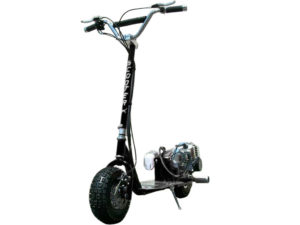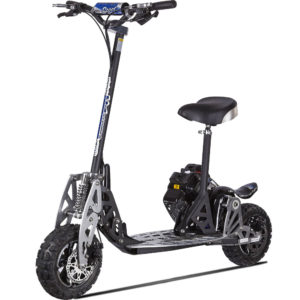Two-Stroke or Four-Stroke? Gas Scooter Showdown
2-stroke or 4-stroke Gas Scooter Engines
Are you contemplating buying a gas scooter and undecided about whether to go for a two-stroke or four-stroke engine? It’s essential to understand that these engines differ in performance, maintenance and fuel efficiency.
This blog post will demystify the fundamental differences between these two options, helping you make an informed decision. Read on as we navigate this occasionally bumpy road together!
Key Takeaways
- Two – stroke engines are lighter and offer more acceleration, but they consume more fuel and produce more pollutants.
- Four – stroke engines are heavier but provide better fuel efficiency, durability, and lower emission levels.
- Consider factors like power output, acceleration, fuel efficiency, maintenance requirements, environmental impact, and cost when choosing between the two.
Understanding the Difference between Two-Stroke and Four-Stroke Engines
Two-stroke and four-stroke engines differ in how they work, with two-strokes requiring a fuel mixture of gasoline and oil, while four-strokes use separate compartments for fuel and lubrication.
How They Work
Two-stroke and four-stroke engines work differently. In a two-stroke engine, the power cycle is completed in one up and down move of the piston. Because of this, these engines are light and small.
They have less parts too. On the other hand, a four-stroke engine has more steps to finish its power cycle. It takes two full turns or revolutions to be done with one cycle which makes it run smoother and quieter than a two-stroke engine.
Also, they have more parts like valves, rods, lifters along with a crankshaft and camshaft.
Pros and Cons of Two-Stroke Engines
Two-stroke engines offer unique benefits and drawbacks, which could impact the performance and usability of your gas scooter.
| Pros | Cons |
|---|---|
| Two-stroke engines are lighter due to fewer moving parts and compact design. | They tend to be less fuel-efficient than their four-stroke counterparts, consuming more fuel over the same distance. |
| They are less expensive to build and purchase, helping to lower the initial cost of your scooter. | Two-stroke engines produce more pollutants, contributing to higher emission levels. |
| With their high power-to-weight ratio, two-stroke engines can provide impressive acceleration and speed. | The regular need for oil mixing and lubrication can be inconvenient and increase maintenance requirements. |
| Thanks to the simple design, parts for two-stroke engines are readily available and often cheaper. | Their lifespan can be shorter than that of four-stroke engines due to the faster wear and tear. |
Considering these factors can assist in making an informed decision on whether a two-stroke engine is suitable for your gas scooter needs.
Pros and Cons of Four-Stroke Engines
Four-Stroke engines have their own set of advantages and disadvantages that you should consider when deciding on what type of engine to choose for your gas scooter.
| Pros | Cons |
|---|---|
| Four-stroke engines are known for their reliable performance and durability. They typically have a longer lifespan compared to two-stroke engines. | They tend to be heavier than two-stroke engines, which can affect the overall maneuverability of the scooter. |
| They produce more torque at lower RPM, making them suited for riders who prioritize power and stability over speed. | Four-stroke engines have a more complex design, which can make them more challenging to maintain and repair. |
| These engines are more fuel-efficient, which can help you save on operating costs in the long run. | Due to their complex design and longer lifespan, four-stroke engines are generally more expensive upfront. |
| Four-stroke engines have lower emissions, which makes them a more environmentally friendly choice. | They don’t accelerate as quickly as two-stroke engines, so they may not be the best choice for riders who prioritize speed. |
Remember, choosing the right engine for your gas scooter ultimately depends on your specific needs and preferences.
Performance Factors to Consider
Consider the power output, acceleration, fuel efficiency, and emission levels when choosing between a two-stroke and four-stroke engine for your gas scooter.
Power Output
The power output of an engine is an important factor to consider when choosing between a two-stroke and four-stroke engine for your gas scooter. Generally, two-stroke engines have a higher power output compared to four-stroke engines.
This means that they can generate more horsepower and torque, resulting in faster acceleration and better performance. If you’re looking for a scooter with quick acceleration and high speed capabilities, a two-stroke engine may be the way to go.
However, it’s important to note that the power output isn’t the only consideration when selecting an engine type for your scooter.
Acceleration
Choosing between a two-stroke and four-stroke engine for a gas scooter depends on various factors, including acceleration. If you’re someone who enjoys speed or racing, the acceleration capability of the engine is crucial.
Two-stroke engines are known for providing quick acceleration and high speeds, making them ideal for those seeking an adrenaline-filled riding experience. On the other hand, four-stroke engines generally deliver smoother power and better low-end torque, which can be advantageous if you prefer a more controlled and steady acceleration.
It’s important to consider your personal preferences and how you plan to use your scooter when deciding on the type of engine that will give you the desired level of acceleration.
Fuel Efficiency
When choosing between a two-stroke and four-stroke engine for your gas scooter, fuel efficiency is an important factor to consider. Four-stroke engines are generally more fuel-efficient compared to two-stroke engines.
This means that they consume less fuel for the same amount of power output. Four-stroke engines burn fuel once every four strokes, while two-stroke engines burn it once every two strokes.
The higher fuel efficiency of four-stroke engines also makes them more environmentally friendly as they produce fewer emissions and pollution. So if you want better fuel economy and reduced environmental impact, it’s recommended to go with a four-stroke engine for your gas scooter.
Emission Levels
When choosing between a two-stroke and four-stroke engine for your gas scooter, it’s important to consider the emission levels. Two-stroke engines, commonly found in scooters and mopeds, are known to produce high levels of hydrocarbons in exhaust emissions.
These hydrocarbon levels can reach up to 5,500 parts per million (ppm), which contributes significantly to air pollution. In comparison, four-stroke engines emit lower levels of hydrocarbons, usually around 850 ppm.
Additionally, two-stroke engines also tend to have higher particulate emissions compared to motorcycles equipped with four-stroke engines. So if you’re concerned about reducing your environmental impact and complying with regulations, opting for a scooter with a four-stroke engine would be a better choice.
Maintenance and Durability
Maintaining and ensuring the durability of your gas scooter is crucial, and it’s important to understand how maintenance requirements differ between two-stroke and four-stroke engines.
Oil Mixing and Lubrication
In two-stroke engines, oil and fuel need to be mixed together before using them in the scooter. This mixture can cause carbon deposits and impurities to build up in the engine over time.
On the other hand, four-stroke engines don’t require this oil-fuel mixing step. Instead, they have a separate lubrication system that uses circulating oil for lubricating the engine’s moving parts and dispersing heat.
This helps prevent carbon buildup and keeps the engine running smoothly for a longer time. So, if you want a gas scooter with less maintenance hassle and better durability, a four-stroke engine may be a better choice for you.
Engine Lifespan
The lifespan of an engine is an important factor to consider when choosing between a two-stroke and four-stroke engine for your gas scooter. Generally, a four-stroke engine is believed to be more durable and have a longer lifespan compared to a two-stroke engine.
This is because four-stroke engines are pressure lubricated with oil, which helps protect the internal components. On the other hand, two-stroke engines rely on mixing oil with fuel for lubrication.
This difference in lubrication methods can affect how long the engine will last. Therefore, if you want an engine that can withstand more wear and tear over time, it may be wise to opt for a four-stroke engine for your gas scooter.
Maintenance Requirements
Maintenance is an important aspect to consider when choosing between a two-stroke and four-stroke engine for a gas scooter. Here are some key points to keep in mind:
- Regular maintenance is crucial for both types of engines to ensure optimal performance and longevity.
- Two-stroke engines require more frequent maintenance compared to four-stroke engines due to their design.
- Maintenance tasks for a two-stroke engine include regularly checking and adjusting the fuel-oil mixture, cleaning or replacing the air filter, and inspecting the spark plug.
- Four – stroke engines usually have a more structured maintenance schedule, including oil changes, valve adjustments, and periodic inspections of various components.
- Both types of engines may require occasional repairs or part replacements over time, so it’s essential to consider the availability of parts and quality of service for your chosen engine type.
Cost Considerations
Consider the initial cost, fuel consumption, and maintenance and repair costs when choosing between a two-stroke and four-stroke engine for your gas scooter.
Initial Cost
When choosing between a two-stroke and four-stroke engine for your gas scooter, one important factor to consider is the initial cost. Generally, two-stroke engines are cheaper to buy compared to four-stroke engines.
This means that if you’re on a tight budget or looking for a more affordable option, a gas scooter with a two-stroke engine could be the way to go. On the other hand, four-stroke engines tend to be more expensive upfront.
However, they may offer certain advantages such as better fuel efficiency and lower maintenance costs in the long run. So while initial cost is an important consideration, it’s essential to weigh it against other factors like future expenses and your specific needs before making a decision.
Fuel Consumption
When choosing between a two-stroke and four-stroke engine for your gas scooter, it’s important to consider fuel consumption. Two-stroke engines are generally less fuel-efficient compared to four-stroke engines.
This means that two-strokes require more fuel to run efficiently. On the other hand, four-stroke engines have lower fuel demands, making them more cost-effective in terms of gas consumption.
So, if you’re looking to save money on fuel expenses, opting for a four-stroke engine would be a wise choice. Remember that proper maintenance and usage of either type of engine can further improve their fuel efficiency and reduce environmental impact by reducing emissions and pollution levels.
Maintenance and Repair Costs

Maintaining and repairing a gas scooter can be an important consideration when choosing between a two-stroke and four-stroke engine. It’s worth noting that four-stroke engines generally require more repairs and maintenance compared to their two-stroke counterparts.
This is because the additional parts and valves in a four-stroke engine contribute to higher maintenance costs. On average, annual maintenance for a four-stroke engine can cost around CAD$600 or even more.
On the other hand, while two-stroke engines may have lower repair costs due to simpler designs without valves, neglecting or abusing them can lead to more severe and costly issues than with a four-stroke engine.
Environmental Impact
Consider the emissions, pollution levels, and compliance with regulations when choosing between a two-stroke and four-stroke engine for your gas scooter.
Emissions
When choosing between a two-stroke and four-stroke engine for your gas scooter, it’s important to consider their emissions. Two-stroke engines emit higher levels of pollutants compared to four-stroke engines.
They produce more smoke, carbon monoxide, hydrocarbons, and particulate matter. This is because two-stroke engines burn an oil-gasoline mixture, which leads to increased emissions.
On the other hand, four-stroke engines are considered more environmentally friendly as they produce fewer pollutants and have lower emission levels overall. It’s crucial to think about the environmental impact of your choice when deciding between these types of engines for your gas scooter.
Pollution
When it comes to pollution, two-stroke engines are a big concern, especially in urban areas. These engines emit more smoke, carbon monoxide, hydrocarbons, and particulate matter compared to four-stroke engines.
Studies have shown that two-stroke engines produce high levels of particulate emissions, which can contribute to climate change and harm our health. In fact, road vehicles like two-stroke scooters are one of the main sources of particulate matter pollution in cities.
So if you’re considering buying a gas scooter, it’s important to think about the environmental impact and choose an engine that produces less pollution.
Compliance with Regulations
Choosing between a two-stroke and four-stroke engine for your gas scooter should also take into account compliance with regulations. Environmental impact is an important consideration, especially when it comes to air pollution and emission control.
Two-stroke engines have been found to produce higher levels of particulate emissions compared to their four-stroke counterparts. If you’re concerned about pollution and want cleaner transportation, opting for a four-stroke engine that burns pure petrol can be a more environmentally friendly choice.
It’s worth noting that the EPA has set emission standards for nonroad spark-ignition engines, including those used in scooters, in order to reduce harmful emissions further.
Riding Experience
Consider the noise level, smoothness of operation, and vibration when choosing between a two-stroke and four-stroke engine for your gas scooter.
Noise Level
When choosing between a two-stroke and four-stroke engine for your gas scooter, one important factor to consider is the noise level. Two-stroke engines tend to be louder than four-stroke engines, especially at idle.
However, as you ride at higher speeds, the noise level between the two types of engines tends to become more similar. Sound testing regulations show that four-stroke engines have a noise level of 94 decibels, while two-stroke engines have a noise level of 96 decibels.
It’s also worth noting that two-stroke engines don’t carry low-frequency sound waves as far as four-stroke engines do. So if reducing engine noise is important to you during your riding experience, you may want to consider opting for a gas scooter with a four-stroke engine.
Smoothness of Operation
A smooth riding experience is an important factor to consider when choosing between a two-stroke and four-stroke engine for your gas scooter. The smoother operation of a four-stroke engine makes it easier to handle, control, and maneuver the scooter.
With a higher torque delivery at lower RPM, a four-stroke engine provides stability while cornering and ensures a comfortable ride. On the other hand, although two-stroke engines may offer more torque at higher RPMs, they can be less smooth in their operation.
So if you prioritize riding comfort and ease of handling, a gas scooter with a four-stroke engine would be the better choice for you.
Vibration
One important factor to consider when choosing between a two-stroke and four-stroke engine for your gas scooter is vibration. Two-stroke engines tend to produce more vibration compared to four-stroke engines.
This vibrating sensation can be felt through the handlebars and footpegs of the scooter, which may affect your overall riding comfort. The increased vibration in two-stroke engines is mainly due to their design and operation.
On the other hand, four-stroke engines are generally smoother and produce less vibration, resulting in a more comfortable ride. So, if a smoother riding experience with minimal vibrations is important to you, then a four-stroke engine may be the better choice for you.
Availability of Parts and Service
Consider the accessibility and availability of parts, as well as the quality of service and support for both two-stroke and four-stroke engines.
Accessibility and Availability of Parts
When choosing between a two-stroke and four-stroke engine for your gas scooter, it’s important to consider the accessibility and availability of parts. This means thinking about how easily you can get replacement parts for the engine if something goes wrong.
Different engines may have different levels of availability when it comes to finding these parts. It’s crucial to research and compare the accessibility and availability of parts as well as service options before making your decision.
That way, you’ll know that if anything happens, you’ll be able to find the necessary parts quickly and easily without any hassle or delays in getting your scooter up and running again.
Quality of Service and Support
When choosing a gas scooter, it’s important to consider the quality of service and support available. This includes the accessibility and availability of parts, maintenance costs, repair expenses, and service reliability.
It’s essential to assess the manufacturer’s support and their track record in providing reliable service for their scooters. Additionally, consider factors such as the complexity of repairs and the availability of spare parts.
Understanding these aspects will help ensure that you have a positive experience with your gas scooter in terms of servicing and support.
Personal Preferences
Consider your familiarity and comfort with a specific engine type, any brand loyalty you may have, and your specific needs and requirements when choosing between a two-stroke and four-stroke engine for your gas scooter.
Familiarity and Comfort
When choosing between a two-stroke and four-stroke engine for your gas scooter, it’s important to consider your own familiarity and comfort with each type. If you have previous experience with one type of engine and feel confident in its operation, you may lean towards choosing that type again.
Additionally, some people simply prefer the way a certain engine feels or sounds while riding. So, when making this decision, trust your instincts and choose the option that makes you feel most comfortable and confident on your gas scooter.
Brand Loyalty
Choosing between a two-stroke and four-stroke engine for your gas scooter can be influenced by brand loyalty. If you have a preferred brand, like Honda, you might lean towards their recommended engine type.
Brand loyalty plays an important role because you trust the quality and performance of that specific brand. It’s natural to feel more comfortable sticking with what you know and trust when making a big purchasing decision like buying a gas scooter.
Don’t underestimate the impact of brand loyalty on your choice of engine type!
Specific Needs and Requirements

Consider your specific needs and requirements when choosing between a two-stroke and four-stroke engine for your gas scooter. Think about what matters most to you in terms of performance, maintenance, cost, environmental impact, riding experience, availability of parts and service, and personal preferences.
If you prioritize power output and acceleration, a two-stroke engine might be more suitable for you. Two-strokes are known for their strong performance in smaller vehicles like motorcycles.
They may also require less maintenance compared to four-strokes.
On the other hand, if fuel efficiency and low emissions are important factors for you, a four-stroke engine is the way to go. Four-strokes are generally more environmentally friendly due to their cleaner combustion process.
They are commonly used in larger vehicles such as cars and trucks.
Conclusion

When choosing between a two-stroke and four-stroke engine for your gas scooter, it’s important to consider factors like power output, fuel efficiency, noise level, and maintenance preferences.
Two-stroke engines offer more power for their weight but may be noisier and produce more exhaust fumes. Four-stroke engines are heavier but generally have better fuel efficiency and smoother power delivery.
Ultimately, the choice depends on what you prioritize in terms of performance, convenience, and environmental impact.
FAQs
1. What is the difference between a two-stroke and four-stroke engine for a gas scooter?
A two-stroke engine completes a power cycle in two strokes of the piston, while a four-stroke engine completes it in four strokes.
2. Which type of engine is more powerful, two-stroke or four-stroke?
Generally, two-stroke engines are known to have higher power output compared to four-stroke engines.
3. Is one type of engine more fuel-efficient than the other?
Four-stroke engines tend to be more fuel-efficient as they consume less fuel for each revolution compared to two-stroke engines.
4. Which type of engine requires less maintenance?
Four-stroke engines generally require less maintenance because they have separate compartments for oil and gasoline, reducing the need for mixing fuels like in a two-stroke engine.
5. How do I choose between a two-stoke and four-strke engine for my gas scooter?
Consider factors such as your riding needs (speed vs efficiency), budget, availability of spare parts/service centers, and personal preference when choosing between a two- stroke and four- stroke engine for your gas scooter.
Source URLs
https://www.berrymanproducts.com/two-stroke-vs-four-stroke-engines/
WARNING:

Before you go Enter the Draw for the Bugatti Electric Scooter Draw Here:
Ebikes Worth Mentioning Click Here
Gotscooters.com
Back to Top
To use our purchasing process you must be 18 years of age or older to purchase any product on our website and not represent or purchase on behalf of anyone under this age as set at the point of purchase. The scooter will be registered on our database to the Name and Address etc of the purchaser.
This post or page may contain affiliate links that may earn a small commission at no additional cost to you. I use affiliate links because they allow me to share useful products and services with you that are related to the topic of my website. Affiliate links also help me earn some income from my website, which enables me to keep creating high-quality content for you. I appreciate your support and trust!
- Health Benefits of Electric Bikes
- What to Look for When Buying an E-bike
- Best Electric eBikes for Your Little One
- How to Safely Unlock the Top Speed on Unagi Electric Scooters
- Breaking: The Shocking Truth About E Scooter Laws in WA!
- Can You Ride Scooters On The Road “California”
- Can Electric Scooters Get Wet? Yes!
- How do I transport my electric scooter in a car?
- Top 6 Long Range Electric Scooters
- Two-Stroke or Four-Stroke? Gas Scooter Showdown



